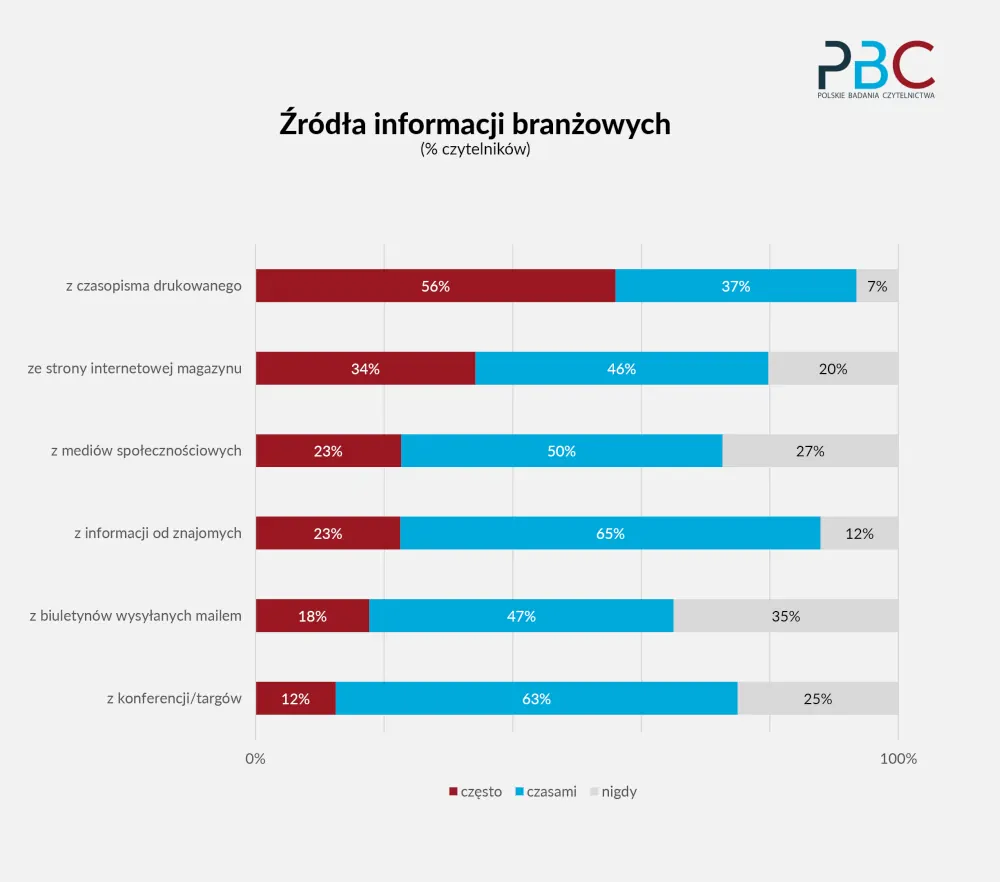 illustration: bing.com/create
illustration: bing.com/createInterest in industry press is shown not only by professionals seeking current knowledge but also by advertisers, for whom it is a well-targeted communication channel with potential clients. Industry titles ensure almost 100% certainty of reaching a full audience of professionals in a given industry, which is a unique characteristic of this category of media. It is an attractive marketing channel, especially for businesses offering B2B services and products.
Readers of industry press are not only people performing specific jobs; they are also individuals keenly interested in developing their skills and knowledge. Industry press is read thoroughly and intensely.
- 91% of readers claim they have read professional titles for 3 years or longer.
- A staggering 81% of people return to previously read issues of magazines at least two times or more.
- 70% of readers share the magazine with others. For respondents, it is an important, key, and primary source of information.
The dominant form of distribution is printed titles received directly at work or home. They serve as the main source of information for professionals. Reading industry magazines allows one to stay updated on professional topics; the knowledge gained from these publications encourages further information searches and discussions with acquaintances. As many as 93% of readers rate industry publications as high quality.
 source: PBC
source: PBCMore than 40% of readers take further actions after reading advertisements - they search for additional information online, visit physical or online stores, want to try the product or service, and consider purchasing it.
When choosing products, readers of industry magazines primarily consider high quality; price, customer reviews, brand recognition, and innovation are also important factors in their decisions.
Research partners: Inżynier Budownictwa, Ogólnopolskie Pismo Rynku FMCG Hurt & Detal, Szef Kuchni Magazyn Branży Gastronomicznej, Top Agrar Polska, Tygodnik Poradnik Rolniczy, Wieści Rolnicze, Zawód: Architekt.
The research was conducted from May to June 2024 using an online questionnaire. It was carried out among readers of industry magazines and supplemented with data from the PBC Audit regarding the distribution forms of industry titles.
The detailed report on the conducted research can be found here: https://www.pbc.pl/czytelnictwo-pism-branzowych-2024/
COMMERCIAL BREAK
New articles in section Media industry
Advertising market 2025. Poland, Europe and the World
Marcin Grządka
The global advertising market is growing by 8.8% in 2025 and will reach a value of 1.14 trillion dollars. The industry result in Europe records slightly lower dynamics, at the level of 5.8%. In this comparison, Poland performs clearly above the average. We will record an increase of 8.9% this year and a value of 18.56 billion PLN - estimates WPP Media in the annual report "This Year Next Year".
The print media market 2025. Three global trends
Krzysztof Fiedorek
The market value is 359.53 billion dollars, yet the erosion is visible to the naked eye. The decline for newspapers will amount to -2.3 percent. Despite this, print retains strength: it generates 76 percent of subscription revenues and enjoys 82 percent consumer trust. The future of the industry is defined by hybrid strategies and niche specialization.
Journalism in the age of AI. Why people prefer humans over machines
Krzysztof Fiedorek
Only 12% of people accept news created solely by AI, while 62% prefer those written by humans. At the same time, only 19% notice labels indicating the use of artificial intelligence, while younger audiences ask AI to explain the content to them. These are the findings of the Reuters Institute report on artificial intelligence in media.
See articles on a similar topic:
Disinformation ranks above terrorism as global threat
KFi
According to "International Opinion on Global Threats" by Pew Research Center, a median of 72% of adults across 25 countries view the spread of false information online as a major threat to their country. That number places disinformation at the very top of perceived global dangers.
Reading Industry Magazines in Poland 2024: PBC Report
Sylwia Markowska
76% of readers of industry magazines are responsible for purchasing decisions in their workplace. To deepen the understanding of the role of industry press and how it is read, PBC surveyed 2051 respondents from 5 different sectors, gaining the latest insights into the reading habits of this segment of the press in Poland.
Blogs in E-commerce. Report by Elephate and Senuto
KrzysztoF
The average number of indexed articles on e-commerce blogs is 565, with each post attracting 347 readers per month. The health industry generates the highest organic traffic per single article. The authors of the "E-commerce Blog Ranking" take a behind-the-scenes look at the commercial blogosphere.
E-commerce Forecasts in Poland. Trends for 2024 and Beyond
Krzysztof Fiedorek
In 2024, e-commerce in Poland is reaching new heights, with an increasing number of consumers regularly shopping online. The report "E-shopping Habits of Poles 2024," prepared by SAMOSEO analysts, analyzes current trends and forecasts the industry's near future.





























